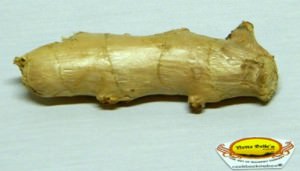I use raw ginger root in many of my food preparations. Not until someone asked how to use it, did I realize not everyone is familiar with the ginger root rhizome. The tan dried root is in the produce area of the grocery, however not refrigerated. Usually is has large knobby extensions from the root. I break off about the size of root as seen above. The Zingibehr officinale, better known as ginger root is a perennial plant from southeastern Asia. It will grow 3-4 feet high. In humid moist climates plants are used in yard planting for the white and pink flowers as well as the foliage.¹
Benefits of Ginger Root
Ginger is an herbal remedy that settles the stomach, intestinal gas, nausea, motion sickness and morning sickness. There are many therapeutic properties in ginger give anti-inflammatory effects. Ginerols are the substances which provide relief to those with pain of osteoarthritis or rheumatoid arthritis. Do not use the dried root or powder if you have gallstones.¹
Uses of Ginger Root
When buying fresh ginger root, be sure the root is firm, smooth and free of mold. Older roots will need to be peeled, easily done with paring knife or vegetable peeler. If left unpeeled, a fresh ginger root will last 3 weeks in the refrigerator and 6 weeks in the freezer.
When using fresh ginger root I do not cut off any more than I will use. Depending on the food I am cooking, it may be diced to minced, julienned or even grated. Adding the ginger at the beginning of cooking will give a milder flavor while adding it later will have a more zesty to spicy flavor.
Ginger root can be grated and put in an ice cube tray with water or in a plastic bag to freeze. When ginger root is needed, just break off what you need. Candied ginger is available in the grocery or candy stores. It is also easily made at home and gives you the ginger syrup.
Ginger Tea
Add 3-4 slices in a cup of boiling water. Or add the slices to a cup of oolong tea or lemon tea.
Candied or Crystallized Ginger
I had frozen the ginger root before starting this recipe. I would have preferred to have made this soon after buying the root. I sliced in 1/4-1/8 crosswise slices, which yielded about 1/2 cup from my pieces. I put them in a heavy saucepan and covered with plenty of water to bring to a boil. I reduced the heat, letting the ginger root simmer about 30 minutes until tender.
After the boiling and simmering, I drained the water off. I put 1 cup of sugar to 1 cup of water in heavy saucepan to dissolve the sugar over low heat. The sugar which collects on the side of the pan can be wash down with a pastry brush dipped in warm water. Bring the sugar to a boil, add the ginger, reduce the heat to simmer and cook until the sugar syrup has almost boiled away. I did not cover the saucepan and stirred occasionally. The ginger and sugar foamed up while cooking but subsides when heat is turned off. Remove the ginger root pieces and lay out on a cookie sheet covered with parchment paper to dry. It make take overnight to dry completely before storing in air tight container.
The sugar water made a nice flavorful ginger syrup. This can be stored in an air tight container and refrigerated and used to sweeten lemonade, teas or poured over ice cream. I want to put some in cookies or in an apple pie. I read it is good with some alcoholic drinks. Lots of possibilities. Parboiling the ginger root first does take out some of the heat of the ginger to a milder taste.²
¹ The World’s Healthiest Foods “Ginger”. www.whfoods.org., June 16-22-2014. ² Adapted from Joy of Cooking.1975. p.881. 
cookbookinabox® in partnership with Netta Belle’s Choice® , bring you great recipes for your cooking experience.
©2007-2018 Netta Belle’s Choice® cookbookinabox® “Reg. U.S. Pat. & Trdmk.Off.” Reg. “Trade-marks Canadian Intellectual Property Office.” nettabelleschoice.com and cookbookinabox.com. All rights reserved. View Post





